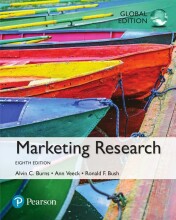Summary: Conceptual Questions International Economics And Businesses
- This + 400k other summaries
- A unique study and practice tool
- Never study anything twice again
- Get the grades you hope for
- 100% sure, 100% understanding
Read the summary and the most important questions on Conceptual Questions International Economics and Businesses
-
1 Chapter 1: The International Economy & Globalization
This is a preview. There are 4 more flashcards available for chapter 1
Show more cards here -
1. Explain briefly – economic interdependence:
An economy’s features - such as industries, service sectors, levels of income & employment, and living standards are linked to its trading partners. International movements of goods and services, labour, business enterprise, investment funds, and technology play an important part. The world is becoming so interconnected that it is no wonder that:
“When the United States sneezes, the economies of other nations catch a cold .”
What is the significance of this saying? -
2. “When the United States sneezes, the economies of other nations catch a cold .”What is the significance of this saying?
It affects the financial markets, ownership of production facilities and labour force. -
4. Therefore, globalization is political, technological. What forces are driving globalisation?
· Technological change in:
o Transport technology
o Information technology
o Communications technology
o Liberalisation of trade and investment
o Development of international financial markets. -
5. The third wave of globalisation has increasingly become the age of “automation.” Explain the term automation.
Age of automation: the third wave of globalization has increasingly become an "age of automation." Automation is the creation of technology, such as robots, used to produce and deliver various goods and services. It performs jobs that humans previously performed. Automation promotes quality and efficiency while reducing the importance of labour costs. Other factors, such as the speed at which firms can get their goods to consumers, access to resources, and workers' skills are more significant. -
6. Explain in full the concept of openness:
· Openness
· Rough measure of the importance of international trade in a nation’s economy
· Nation’s exports and imports as a percentage of its gross domestic product (GDP)
· Large countries – lower measures of openness (Why?)
· Less reliant on international trade
· Small countries – higher measures of openness -
2 Chapter 2: Foundations of Modern Trade Theory: Comparative Advantage
This is a preview. There are 2 more flashcards available for chapter 2
Show more cards here -
1. How does Hume’s perspective (price-specie-flow-doctrine) critique the ideas put forth by the mercantilists?
Favourable trade balance is possible only in short run. -
2. What is the argument between Adam’s principle of absolute advantage and Ricardo’s principle of comparative advantage?
Adam Smith ’s Principle ofAbsolute Advantage:Absolute cost advantage (Supply side of the market) Uses lesslabour toproduce one unit ofoutput . Labour Theory ofValue
- Productioncosts differ amongnations
- Differentproductivities of factorinputs
- Labour ishomogenous
- Eachnation must have a good that it isabsolutely moreefficient inproducing than itstrading partner . Thus: Importgoods – if there is an absolute costdisadvantage .Export goods – if there is absolute cost advantage. -
4. How are the terms of trade measured?
Commodity terms of trade also calledBarter terms of trade:Measure of theinternational exchange ratioMeasures the relation between the prices a nation gets for itsexports and the prices it pays for itsimports .- Terms of Trade =
Export Price Index / Import Price Index times 100
-
Changing comparative advantage – Read about the productivity and the shift in the comparative advantage between Japan and the U.S. Figure 2.3 of Carbaugh’s 18th edition): Print out slides 15 and 16:
Patterns of comparative advantage change over time:
· Productivity increases
· Production possibilities schedule
· changes
· More output can be produced - with the
· same amount of resources
· Producers - need to hone their skills to
· compete in more profitable areas. -
3 Chapter 3: Sources of Comparative Advantage 11
This is a preview. There are 14 more flashcards available for chapter 3
Show more cards here -
10. Intra – Industry Trade:
The exchange between nations of products of different industries. Inter – industry trade involves the exchange of goods with different factor requirements. Nations having large supplies of skilled labour tend to export sophisticated manufactured products, while nations with large suppliers of natural resources export resource – intensive goods. Much of inter – industry trade is between nations having vastly different resource endowments.
- Higher grades + faster learning
- Never study anything twice
- 100% sure, 100% understanding































